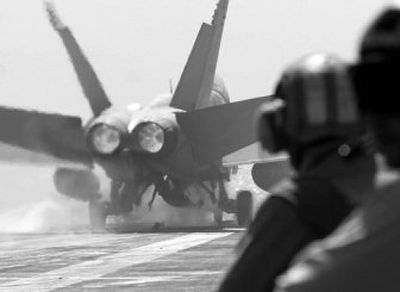U.S. jets dropping twice as many bombs on Iraq

BAGHDAD – Four years into the war that opened with “shock and awe,” U.S. warplanes have again stepped up attacks in Iraq, dropping bombs at more than twice the rate of a year ago.
The airpower escalation parallels a nearly four-month-old security crackdown that is bringing 30,000 additional U.S. troops into Baghdad and its surroundings – an urban campaign aimed at restoring order to an area riven with sectarian violence.
It also reflects increased availability of planes from U.S. aircraft carriers in the Persian Gulf. And it appears to be accompanied by a rise in Iraqi civilian casualties.
In the first 4 1/2 months of 2007, American aircraft dropped 237 bombs and missiles in support of ground forces in Iraq, already surpassing the 229 expended in all of 2006, according to U.S. Air Force figures.
“Air operations over Iraq have ratcheted up significantly, in the number of sorties, the number of hours (in the air),” said Col. Joe Guastella, Air Force operations chief for the region. “It has a lot to do with increased pressure on the enemy by MNC-I” – the Multinational Corps-Iraq – “combined with more carriers.”
The Air Force report did not break down the specific locations in Iraq where bombings have been stepped up. But U.S.-led forces also are locked in new and dangerous fronts against insurgents outside Baghdad in such places as Diyala, a province northeast of the capital.
A second U.S. Navy aircraft carrier on station since February in the Persian Gulf has added some 80 warplanes to the U.S. arsenal in the region.
At the same time, the number of civilian Iraqi casualties from U.S. airstrikes appears to have risen sharply, according to Iraq Body Count, a London-based, anti-war research group that maintains a database compiling news media reports on Iraqi war deaths.
The rate of such reported civilian deaths appeared to climb steadily through 2006, the group reports, averaging just a few a month in early 2006, hitting some 40 a month by year’s end, and averaging more than 50 a month so far this year.
Those are maximum tolls based on news reports, and they count those killed by Army helicopter fire as well as by warplanes, Iraq Body Count’s John Sloboda said. The count is regarded as conservative, since it doesn’t include deaths missed by the international media.
Air Force figures show that, after the thousands of bombs and missiles used in the 2003 “shock and awe” invasion, U.S. airpower settled down to a slow bombing pace: 285 munitions dropped in 2004, 404 in 2005 and 229 in 2006, totals that don’t include warplanes’ often-devastating 20mm and 30mm cannon or rocket fire, or Marine Corps aircraft.
The number of Air Force and Navy “close air support” missions, which usually involve a flyover show of force or surveillance work, rather than bombing, also has grown by some 30 to 40 percent this spring, said Army Lt. Col. Bryan Cox, a ground-forces liaison at the regional air headquarters.